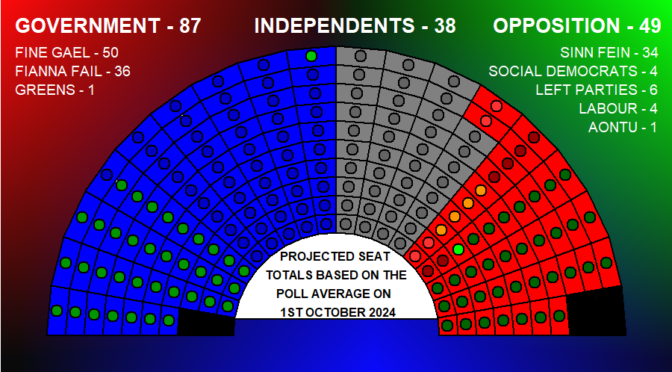This Poll Average was calculated by doing a time-rated average of the last five Irish Opinion Polls (with adjustments for each polling compant based on their historical deviation from the overall average of polls). Regional sub-data for Dublin and the provinces is also used to account for Regional Swings.
The main points of this Poll Average are :
- The Government Parties (Fine Gael, Fianna Fáil, Greens) would take 87 seats – 50 for Fine Gael, 36 for Fianna Fáil and 1 for the Greens.
- The Opposition Parties (Sinn Féin, Labour, Social Democrats, Solidarity-People Before Profit, Aontu) would take 49 seats – 34 for Sinn Féin, 4 for Labour and 11 for the other 3 parties.
Bear in mind that there 14 extra seats in the new Dáil.

MAIN RESULTS
The Overall National Results are as follows :
| PARTY | % | (+/- 2020) | SEATS | (+/- 2020) |
| GOVERNMENT | 48% | -2% | 87 | +2 |
| Fine Gael | 25% | +4% | 50 | +15 |
| Fianna Fáil | 19% | -3% | 36 | -2 |
| Greens | 4% | -3% | 1 | -11 |
| OPPOSITION | 33% | -5% | 49 | -7 |
| Sinn Féin | 19% | -6% | 34 | -3 |
| Labour | 4% | 4 | -2 | |
| Others | 10% | +1% | 11 | -2 |
| INDEPENDENTS | 19% | +7% | 38 | +19 |
Note : Others includes smaller parties (Social Democrats, Aontu and Solidarity-People Before Profit) grouped together as the method I use to determine swing doesn’t work well with small numbers. The individual seat numbers for these parties are – Solidarity-People Before Profit 6, Social Democrats 4, Aontu 1. These parties will be generally targetting specific constituencies for seat gains and holds, whereas the three larger parties will be actively contesting each (or nearly each) constituency.
In terms of Government formation, the Government parties (Fianna Fáil, Fine Gael and the Greens) would take 48% of the vote and 87 of the 174 seats – exactly half. The Opposition (Sinn Féin, Social Democrats, Labour, Solidarity and People Before Profit, and Aontu) would take 33% of the vote and 49 of the 174 seats – far far short of a majority. I will make a caveat that I think that the Independent seat take is probably overstated – particularly in Dublin at 9 seats. That said, where there are electable Independents standing in Dublin on polling day – and some Independents notched up impressive wins in the locals – they are likely to have a good day.
I’d have to add a caveat that the Social Democrats seat total is probably underestimated given that they are polling strongly – on the other hand the only other constituency they polled decently in in 2020 (besides the six constituencies they won a seat in) was Galway West, and their seat in Cork South-West – not withstanding the incumbent’s elevation to their leadership – could potentially be vulnerable on paper at least.
PROVINCIAL RESULTS
| PARTY | DUBLIN | LEINSTER | MUNSTER | CONN.-ULS. |
| GOVERNMENT | 48% | 49% -3 | 50% -2 | 46% –4 |
| Fine Gael | 26% +5 | 25% +4 | 23% +3 | 25% +2 |
| Fianna Fáil | 16% +1 | 21% -4 | 23% -3 | 18% -4 |
| Greens | 6% -6 | 3% -3 | 4% –2 | 3% -2 |
| OPPOSITION | 35% -10 | 36% -2 | 27% -3 | 30% -4 |
| Sinn Féin | 15% -12 | 22% -4 | 16% -4 | 23% -4 |
| Labour | 5% -1 | 6% +1 | 3% -2 | 1% |
| Others | 15% +3 | 8% +1 | 8% +3 | 6% |
| INDEPENDENTS | 17% +10 | 15% +5 | 23% +5 | 24% +8 |
Looking firstly at the overall Bloc figures the government parties remain steady in Dublin, while falling back slightly in the provinces. By contrast, the opposition lose heavily in Dublin, with less dramatic falls of support in the province. Conversely the Independent vote more than doubles in Dublin.
In 2020, Sinn Féin took 27% in Dublin compared to 7% for Independent candidates. On this poll average, Independents on 17% edge ahead of Sinn Féin on 15%. Despite their vote nearly halving, on this result Sinn Féin would not lose that many seats in Dublin as in 2020 they did not run enough candidates to take advantage of their large vote haul – extra seats could have been won in Dublin South-Central, Dublin North-West, Dublin Bay North, Dublin Central and Dublin South-West. You’d have to wonder if at least part of that Independent (and small parties) gain is going to anti-immigrant/far-right candidates and parties.
| PARTY | DUBLIN | LEINSTER | MUNSTER | CONN.-ULS. |
| GOVERNMENT | 24 -1 | 23 | 25 +2 | 15 +1 |
| Fine Gael | 14 +4 | 14 +4 | 13 +5 | 9 +2 |
| Fianna Fáil | 9 +2 | 9 -2 | 12 -1 | 6 -1 |
| Greens | 1 -7 | 0 -2 | 0 –2 | 0 nc |
| OPPOSITION | 16 -4 | 18 +3 | 7 -5 | 8 nc |
| Sinn Féin | 8 -2 | 12 +1 | 6 -2 | 8 nc |
| Labour | 1 -1 | 3 +1 | 0 -2 | 0 nc |
| Others | 7 -1 | 3 +1 | 1 -1 | 0 nc |
| INDEPENDENTS | 9 +9 | 7 +2 | 14 +6 | 8 +1 |
Looking at those numbers in terms of blocs, the Government parties (Fianna Fáil, Fine Gael and the Greens) would take 40% of the vote and 76 of the 174 seats – 12 short of a majority. The Opposition (Sinn Féin, Social Democrats, Labour, Solidarity and People Before Profit, and Aontu) would take 41% of the vote and 70 of the 174 seats – 18 short of a majority.
I’d have to add a caveat that the Social Democrats seat total is probably underestimated given that they are polling strongly – on the other hand the only other constituency they polled decently in in 2020 (besides the six constituencies they won a seat in) was Galway West, and their seat in Cork South-West – not withstanding the TD’s elevation to their leadership – could potentially be vulnerable on paper at least.
Below I’ve drawn – using my rather basic Matplotlib Skills – the proportions of seats each party/block would take per region. The Government parties are shaded in Green, the opposition parties in Red, and Independents in Gray.
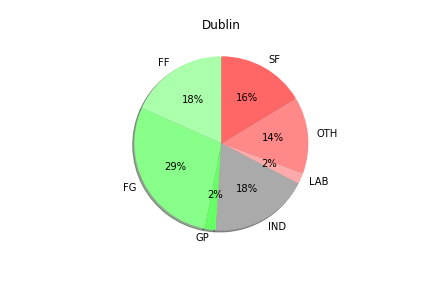
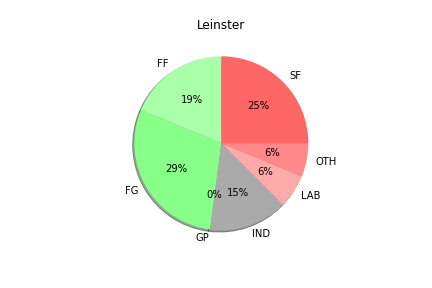
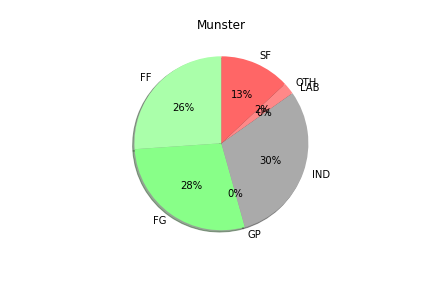
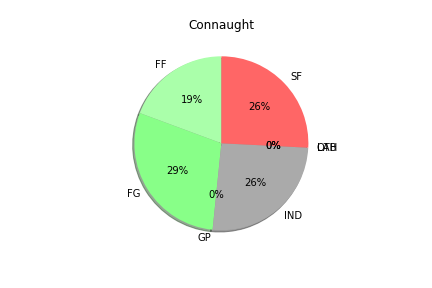
The first thing to notice is that the seat take for the Government parties is fairly uniform across the provinces, hovering around half the seats in each area/province. By contrast the success the opposition had varied widely – they took at least a third of the seats in the east (Dublin and Leinster), but only a sixth in Munster and a quarter in Connaught and Ulster. Part of the reason is the strong performance by Independent candidates in the latter provinces.
DEMOGRAPHIC RESULTS
The barcharts below show party (and group) performance in Social Class and Age demographics. The Government parties are grouped in shades of Green, Opposition parties in shades of Red. “Others” consists of Labour, Social Democrats. Aontu and Solidarity-People Before Profit.


Dealing with class first, the Government parties enjoy majority backing of Middle Class voters (53%) and Farmers (68%) – in the latter group they lead the opposition 4 to 1. Amongst working-class voters, the margin is smaller, but the Government still lead the opposition by about five points – however note Independents attract nearly a quarter of Working-Class votes.
The opposition lead the Government amongst younger voters, but fail to attract majority support. By contrast, among Older voters the Government attract nearly 60% of voter support and lead the opposition by over 2 to 1.
POSSIBLE CONSTITUENCY CHANGES
Below is the possible seat changes based solely on the projected swing per party in each region. Please note – this is not a projection of what will happen in the General Election, not does it take into account candidate or other factors local to individual constituencies.
| PARTY | GAINS | LOSSES |
| SF | LEINSTER : Wexford-Wicklow / CONNAUGHT-ULSTER : Galway East | DUBLIN : Dublin Bay South, Dublin Mid-West / MUNSTER : Clare, Tipperary South / CONNAUGHT-ULSTER : Galway-Roscommon |
| FG | DUBLIN : Dublin Bay South, Dublin Fingal West, Dublin South-Central, Dun Laoghaire / LEINSTER : Longford-Westmeath, Meath East, Offaly, Wexford-Wicklow / MUNSTER : Cork North-West, Cork South-West, Tipperary North, Tipperary South, Waterford CONNAUGHT-ULSTER : Cavan-Monaghan / Galway-Roscommon | |
| FF | DUBLIN : Dublin Mid-West, Dublin Rathdown / LEINSTER : Louth, Wexford-Wicklow / MUNSTER : Clare | LEINSTER : Kildare South, Longford-Westmeath, Wexford, Wicklow / MUNSTER : Cork North-West, Tipperary North / CONNAUGHT-ULSTER : Cavan-Monaghan |
| GP | DUBLIN : Dublin Central, Dublin Fingal West, Dublin Rathdown, Dublin South-Central, Dublin South-West, Dublin West, Dun Laoghaire / LEINSTER : Carlow-Kilkenny, Wicklow / MUNSTER : Limerick City, Waterford | |
| SD | DUBLIN : Dublin Bay North, MUNSTER : Cork South-West | |
| LAB | LEINSTER : Kildare North, Kildare South | DUBLIN : Dublin Fingal East / LEINSTER : Louth / MUNSTER : Cork East, Tipperary |
| LEFT | DUBLIN : Dublin West | DUBLIN : Dublin Mid-West, Dublin South-Central / MUNSTER : Cork North-Central |
| AON | ||
| INDS | DUBLIN : Dublin Bay North, Dublin Central, Dublin Fingal East, Dublin Fingal West, Dublin Mid-West, Dublin Rathdown, Dublin South-Central, Dublin South-West, Dublin West / LEINSTER : Carlow-Kilkenny, Longford-Westmeath, Wicklow / MUNSTER : Cork East, Cork North-Central, Cork South-Central, Limerick City, Tipperary North, Tipperary South |
CAVEAT : The above seat changes and the calculations are based solely on regional swings – they’re not based on demographics, candidates etc.
NOTES :
1. All seats in Wexford-Wicklow won are treated as gains. This is because none of the ten representatives elected in the old Wexford and Wicklow constituencies in 2020 are based in what will be the the new Wexford-Wicklow constituency. These three “gains” will be offset by a loss in both the Wicklow and Wexford constituencies.
CONCLUSION
The first thing to note is that in 2020 Sinn Féin – despite gaining nearly two quotas in Dublin Bay North, Dublin Central, Dublin South-Central, Dublin South-West and Dublin Bay North – took only seat in each constituency as the party only had one candidate standing in each constituency. However, the recent patterns in poll averages suggest that in none of these constituencies would Sinn Fein now win a second seat with their Dublin vote nearly halving. In fact according to this Poll Average, at the moment they would actually likely lose seats in Dublin Bay South and Dublin Mid-West.
By contrast, Fine Gael would make gains in all parts of the country, with consistent gains in each province. They would also be the biggest party in each province.
In previous analyses, the Green Party generally held onto three or four seats in Dublin (while being wiped out beyond the M50) due to their vote holding up relatively well in the Capital. However a further slide in their vote there sees them only holding on in Dublin Bay South – and this analysis is based upon the 2020 General Election figures, not the 2021 bye-election. In Fingal, Joe O’Brien, despite being one of the few Green TDs to have a strong local base in the town of Skerries (35% in 2020, 51% in the 2019 bye-election), sees his vote cut in half by the partition of Fingal. Their problem is that previously their remaining support – about 4 to 5% – was disproportionately based in Dublin. However, their support in Dublin has recently fallen and the compensating gain in the provinces is not enough to retain seats.
Almost quixotically, the predictor throws up two gains for Labour – both in Kildare. In Kildare South, a four seat contest would give Labour a good chance of leveraging their massive support in the south of the constituency around Athy to take a seat. The situation in Kildare North is more complex – with Fianna Fáil and Fine Gael both looking to get two seats, and Sinn Féin and the Social Democrats looking to keep their one. If Labour can get close to half a quota on the first count – and a decent transfer off the Greens – they’d have a reasonable chance of being competitive for the last seat. Elsewhere, they are looking at a likely loss in Cork East (largely due to the removal of Mallow) and possible losses in Tipperary North and Louth. In the latter two constituencies, Alan Kelly’s fate will be largely determined by the vote in the town of Nenagh and the accompanying baronies of Owney and Arra and Upper Ormond, while in Louth Ged Nash is dependent on the vote in Drogheda. Labour’s remaining TDs are largely reliant on the electoral largesse of localised fiefdoms.
As regards the Smaller parties, Solidarity/People Before Profit and Independents For Change are facing a possible loss in Dublin South-Central. On the plus side, the extra seat in Dublin West should see a gain there.
The calculator suggests a loss of Holly Cairns’ seat in Cork South-West on the cold hard figures, but whether that transpires in is another matter – her vote is very much local and unlikely to be swayed much by national or regional poll figures.
Lastly, the predictor predicts a slew of Independent gains across Dublin, Leinster and Munster. Whether they materialise – ie whether an independent candidate capable of taking them will be in situ in each constituency – is another question, particularly in Dublin.
Thanks for reading.
